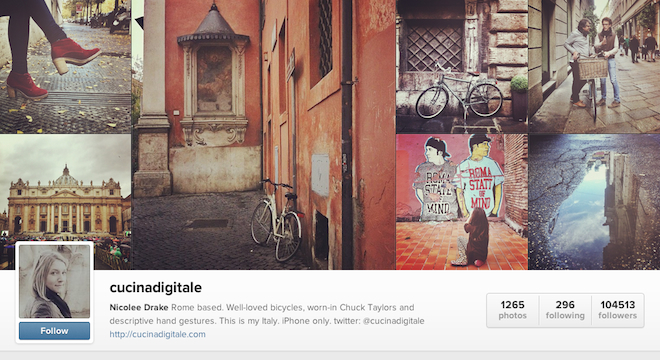Updated 9:50 a.m. EST, Tuesday, November 6
Instagram, the popular photo-sharing app, is about to become even more visible: On Monday, the company announced that it had begun launching new, desktop Web profiles for its users.
The move, which had been leaked earlier by All Things D, marks a major departure from a proven model that has gained Instagram so much success — specializing in mobile.
The popular photo-editing and sharing social network began in 2010 as an iPhone app and only finally expanded to Android in April, just days before Instagram was acquired by Facebook for a record $1 billion, despite having no revenue stream of its own to speak of.
So it wasn’t exactly a surprise to see that Instagram’s new web profiles closely resemble its new corporate overlord Facebook’s user profiles, complete with a large, landscape “cover photo” space at the top and a short text bio and smaller bio photo underneath, followed by a series of recent image posts (though it is worth noting that the top photo space on Instagram for web is actually made up of a dynamic, constantly rotating grid of several of a user’s photos).
See a screenshot of the new Facebook-like Instagram profiles here:
Despite the resemblance, the new Instagram Web profile template “was built by the Instagram team,” an Instagram spokesperson said in a statement to TPM.
“Your web profile features a selection of your recently shared photographs just above your profile photo and bio, giving others a snapshot of the photos you share on Instagram,” wrote Instagram in a blog post. “In addition, you can follow users, comment & like photos and edit your profile easily and directly from the web. It’s a beautiful new way to share your Instagram photos!”
As for why Instagram decided to make this change now, Instagram CEO Kevin Systrom provided the following statement to TPM: “People have been asking for this for a while now and we’re excited to finally start rolling them out.”
Instagram has had a banner year, even for a white-hot tech startup. Aside from getting acquired by Facebook, it’s seen its user base grow from 30 million to upwards of 100 million, buoyed in part by famous adopters including pop star Justin Bieber, rapper Snoop Dogg and President Obama.
The company’s rise has also spawned a wake of imitators and add-on apps.
But Instagram itself is still gaining users at a rapid clip (it’s the 15th most popular free app at the time of this article’s publication).
On top of all that, Hurricane Sandy may have proven to be a defining moment for Instagram’s adoption and usage: The storm was the single-most photographed and shared event in the company’s history, with 800,000 photos tagged with the storm’s moniker (#Sandy), nearly 10 times the number of photos shared during the 2012 Superbowl, Instagram’s previous mass record for photo sharing of a singular event. New Web profiles are only likely to help increase its popularity and adoption by other major users and companies.
At the same time, the new Facebook-like profiles for Instagram on the web again raise the question over just how independent Instagram will remain from Facebook.
Facebook CEO Mark Zuckerberg has repeatedly stated his intent to keep the two social networks distinct, in September telling an audience at the TechCrunch Disrupt conference in San Francisco that “We have no agenda with making them [Instagram] go onto our infrastructure.”
Yet Zuckerberg also admitted that his company, which itself now counts over 1 billion users, has struggled to keep up with the massive adoption of mobile devices and provide a fast, simple, easy and generally high-quality mobile Facebook experience to users, as well as to increase monetization of its mobile ad offerings. Buying Instagram was supposed to help with that.
As Facebook’s own third-quarter earnings report for 2012, published in late October, notes, Instagram “is expected to enhance our photos product offerings and to enable users to increase their levels of mobile engagement and photo sharing.”
Instagram’s small team has moved into Facebook’s Palo Alto, California headquarters. Instagram has also long supported Facebook integration, allowing users to post their Instagram photos to their Facebook profiles and show on Facebook the photos they’ve liked on Instagram, if the user elects to log into both social networks.
It remains to be seen whether Instagram Web profiles will end up displaying Facebook interactions or advertisements on them, too (so far there doesn’t seem to be space for that, but time will tell).
“There are not changes to the integration right now,” between the two disparate social networks, Instagram’s spokesperson told TPM.
At the very least, the move to make Instagram Web profiles is a curious one, given the overall trend toward mobile devices, away from desktop interaction. Instagram notably doesn’t yet have a dedicated tablet app for either Apple’s iPad or Android tablets (though Instagram does support a modified view for both). The new Web app, built using HTML 5, does seem to be a stopgap way to provide a more tablet-optimized experience without launching dedicated tablet apps.
Also, Instagram’s increasing Web presence may explain why Twitter is reportedly preparing to release Instagram-like colored and textured photo-filters of its own. (Twitter was reportedly in acquisition talks with Instagram prior to the announcement of the Facebook deal, and Twitter co-founder Jack Dorsey notably stopped using Instagram to post images to Twitter after the acquisition was announced, though his Instagram account remains up).
Updated throughout to add information from Facebook and Instagram.







